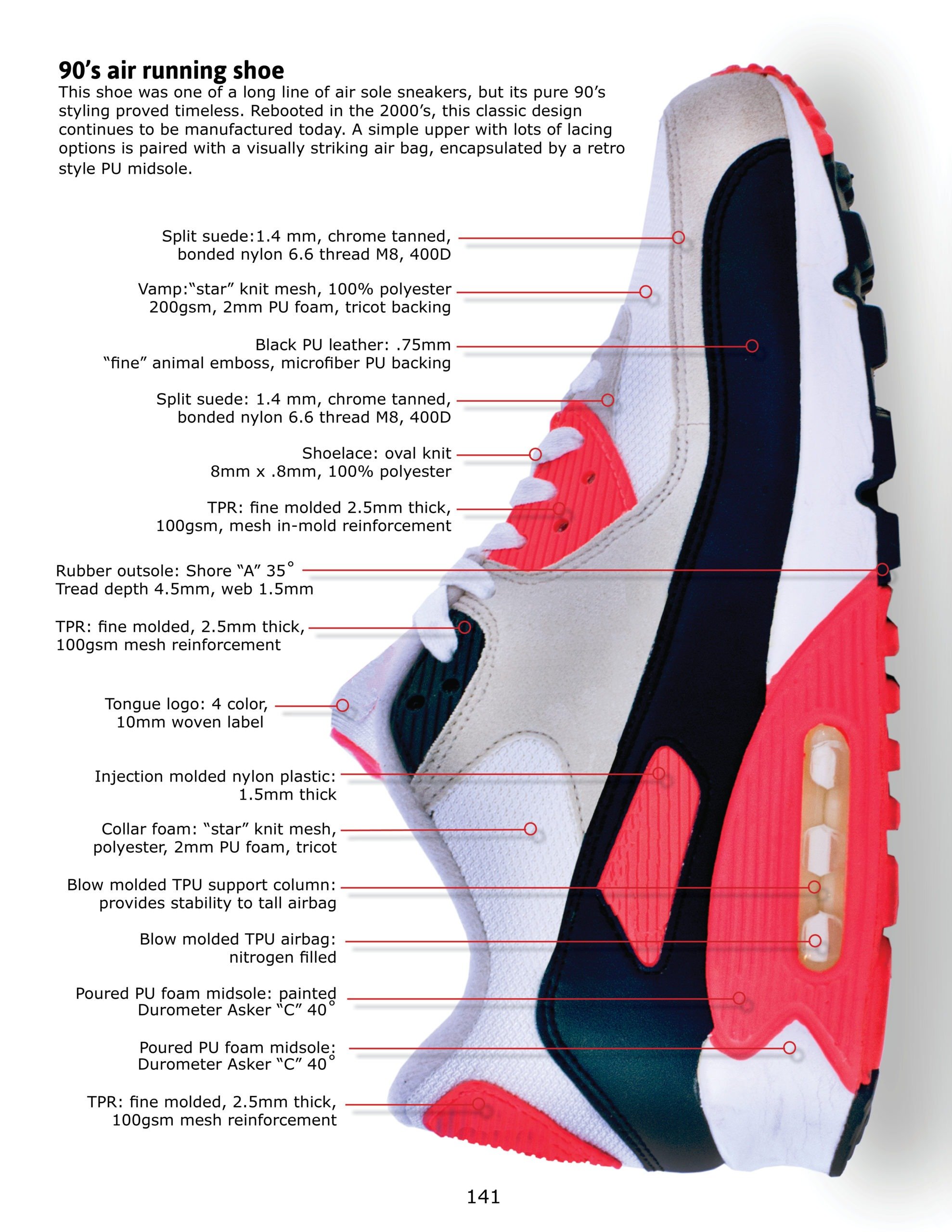What are shoes made of? Shoes are crafted from a wide variety of materials, chosen for their properties like durability, comfort, and appearance. These shoe materials range from natural options like leather and rubber to synthetic alternatives like plastics and textiles. This comprehensive guide dives into the world of footwear construction, exploring the various shoe components and the shoe material types used in their creation.

Image Source: shoemakersacademy.com
Deconstructing a Shoe: The Key Components
Before diving into the specific materials, it’s crucial to know the different parts of a shoe. Each part has a specific function and often uses different materials to achieve the desired performance.
- Upper: The part that covers the foot.
- Insole: The interior part that the foot rests upon.
- Midsole: Located between the insole and the outsole, providing cushioning and support.
- Outsole: The bottom layer that comes into contact with the ground.
- Lining: The material on the inside of the upper, providing comfort and breathability.
- Heel Counter: A stiff piece at the back of the shoe that provides support and stability to the heel.
- Toe Box: The front part of the shoe that encloses the toes.
Natural Shoe Materials: The Classics
Natural materials have been used in footwear construction for centuries, valued for their breathability, durability, and comfort.
Leather: A Timeless Choice
Leather shoes remain a popular choice due to their durability, flexibility, and ability to mold to the foot. Different types of leather offer varying characteristics.
- Full-Grain Leather: The highest quality leather, retaining the natural grain. It’s strong, durable, and develops a patina over time. Used in high-end shoe materials.
- Top-Grain Leather: The second-highest quality, with the top layer sanded and finished. It’s more flexible than full-grain but less durable.
- Split-Grain Leather: Made from the fibrous part of the hide, with an applied coating. It’s less expensive but also less durable. Suede and nubuck are types of split-grain leather.
- Bonded Leather: Recycled leather scraps bonded together. The least expensive and least durable type of leather.
Pros and Cons of Leather
| Feature | Pros | Cons |
|---|---|---|
| Durability | Excellent, especially full-grain leather. | Can be damaged by water and require regular conditioning. |
| Breathability | Very breathable, allowing moisture to escape. | More expensive than synthetic shoe materials. |
| Comfort | Molds to the foot over time, providing a customized fit. | Can be stiff initially and require a break-in period. |
| Appearance | Classic and stylish look. | Can be scratched and scuffed easily. |
| Environmental Impact | Requires tanning processes that can have environmental consequences. | Raising livestock for leather contributes to greenhouse gas emissions. |
Rubber: For Grip and Durability
Rubber is a crucial sole material, known for its grip, durability, and water resistance.
- Natural Rubber: Derived from the sap of rubber trees. It offers excellent grip and flexibility.
- Synthetic Rubber: Created from petroleum-based products. Different types of synthetic rubber, like SBR and Neoprene, offer specific properties like oil resistance and abrasion resistance.
Pros and Cons of Rubber
| Feature | Pros | Cons |
|---|---|---|
| Grip | Excellent grip on various surfaces. | Can be heavy and less flexible than some other sole materials. |
| Durability | Highly durable and resistant to abrasion. | Can become brittle over time, especially with exposure to UV light. |
| Water Resistance | Waterproof and resistant to moisture damage. | Not as breathable as leather or some synthetic materials. |
| Cost | Relatively inexpensive, especially synthetic rubber. | Can have a strong odor, especially natural rubber. |
| Sustainability | Natural rubber is renewable, but sourcing can be problematic. | Synthetic rubber is derived from fossil fuels. |
Other Natural Materials
Besides leather and rubber, other natural materials find use in shoe construction:
- Cotton: Used for linings and uppers due to its breathability and softness.
- Wool: Used for linings and insulation, providing warmth and moisture-wicking properties.
- Cork: Used for insoles and midsoles, offering cushioning and support.
- Jute: Used for espadrille soles, providing a natural and lightweight option.
Synthetic Shoe Materials: Innovation and Affordability
Synthetic shoe materials have revolutionized footwear construction, offering a wide range of properties and price points.
Polyurethane (PU): Versatile and Durable
PU is a versatile polymer used in various shoe components, including outsoles, midsoles, and uppers.
- Properties: Durable, flexible, lightweight, and water-resistant. It can be molded into various shapes and textures.
Polyvinyl Chloride (PVC): Cost-Effective and Waterproof
PVC is a synthetic plastic used primarily in inexpensive shoes, especially for outsoles and uppers.
- Properties: Waterproof, durable, and cost-effective. However, it’s less flexible and breathable than other materials.
Ethylene-Vinyl Acetate (EVA): Lightweight and Cushioning
EVA is a foam material commonly used in midsoles for its cushioning properties.
- Properties: Lightweight, flexible, and provides good shock absorption.
Nylon and Polyester: Strong and Versatile Textiles
Nylon and polyester are synthetic textiles used for uppers and linings.
- Properties: Strong, durable, water-resistant, and available in a wide range of colors and textures.
Microfiber: Leather Alternative
Microfiber is a synthetic material made of very fine fibers. It’s often used as a leather alternative in shoe materials.
- Properties: Lightweight, breathable, water-resistant, and durable. It can mimic the look and feel of leather.
Pros and Cons of Synthetic Materials
| Feature | Pros | Cons |
|---|---|---|
| Durability | Many synthetics offer excellent durability. | Some synthetics are less durable than high-quality leather. |
| Water Resistance | Many synthetics are water-resistant or waterproof. | Can be less breathable than natural materials. |
| Cost | Generally less expensive than natural materials. | Can feel less comfortable than natural materials, especially in hot weather. |
| Versatility | Can be engineered with specific properties for different applications. | Environmental concerns related to production and disposal. |
| Animal Friendly | Provide alternatives to animal-derived materials. | May not biodegrade as easily as natural materials. |
Exploring Shoe Components and Their Materials
Let’s delve deeper into the specific materials used in each shoe component.
Upper Materials
The upper material determines the shoe’s appearance, comfort, and durability. Common options include:
- Leather: Provides classic style, breathability, and durability.
- Synthetic Leather (Microfiber, PU): Offers a leather-like appearance with enhanced water resistance and lower cost.
- Nylon Mesh: Provides excellent breathability and flexibility, often used in athletic shoes.
- Canvas: A durable and breathable cotton fabric, often used in casual shoes.
- Knit Fabrics: Offer flexibility, breathability, and a snug fit, increasingly popular in athletic and casual footwear.
Insole Materials
The insole materials provide cushioning and support for the foot.
- EVA Foam: A common choice for its lightweight cushioning.
- Polyurethane Foam: Offers more durability and support than EVA foam.
- Cork: Provides natural cushioning and molds to the foot over time.
- Leather: Used in high-end shoes for its comfort and breathability.
Midsole Materials
The midsole is crucial for shock absorption and support.
- EVA Foam: A popular choice for its lightweight cushioning. Different densities of EVA foam can be used to achieve varying levels of support.
- Polyurethane Foam: Offers greater durability and stability than EVA foam.
- Thermoplastic Polyurethane (TPU): Provides excellent support and energy return, often used in performance footwear.
Outsole Materials
The outsole materials need to be durable, provide grip, and resist abrasion.
- Rubber: A versatile choice, offering good grip and durability. Different rubber compounds can be used to optimize grip and wear resistance.
- Thermoplastic Rubber (TPR): A cost-effective alternative to rubber, offering good grip and flexibility.
- Polyurethane (PU): Can be used for outsoles, providing good durability and abrasion resistance.
| Component | Material Examples | Properties |
|---|---|---|
| Upper | Leather, Synthetic Leather, Nylon Mesh, Canvas, Knit | Durability, Breathability, Flexibility, Water Resistance, Aesthetics |
| Insole | EVA Foam, Polyurethane Foam, Cork, Leather | Cushioning, Support, Moisture Absorption |
| Midsole | EVA Foam, Polyurethane Foam, TPU | Shock Absorption, Stability, Energy Return |
| Outsole | Rubber, TPR, Polyurethane | Grip, Durability, Abrasion Resistance, Flexibility |
| Lining | Cotton, Leather, Synthetic Fabrics | Comfort, Moisture Absorption, Breathability |
The Environmental Impact of Shoe Materials
The production and disposal of shoe materials have significant environmental consequences. Choosing sustainable materials and manufacturing processes is increasingly important.
- Sustainable Materials: Explore options like recycled materials, organic cotton, and plant-based leather alternatives.
- Ethical Production: Support brands that prioritize fair labor practices and environmentally responsible manufacturing.
- Shoe Care and Longevity: Proper shoe care can extend the lifespan of your shoes, reducing the need for frequent replacements.
- Recycling and Upcycling: Explore shoe recycling programs or repurpose old shoes for other uses.
Matching Materials to Shoe Types
The best shoe material types depend greatly on the shoe’s intended use.
- Athletic Shoes: Lightweight, breathable, and supportive materials like nylon mesh uppers, EVA midsoles, and rubber outsoles are common.
- Dress Shoes: Leather uppers and soles are traditional choices, offering a classic look and durability.
- Casual Shoes: A wide range of materials can be used, depending on the desired style and comfort level. Canvas, suede, and knit fabrics are popular choices.
- Boots: Durable and water-resistant materials like leather or synthetic leather are essential for protecting the feet from the elements.
- Sandals: Lightweight and breathable materials like leather, rubber, and synthetic fabrics are common.
Frequently Asked Questions (FAQ)
- What is the most durable material for shoe soles?
- Durable shoe soles often use rubber because it resists wear. Special types of rubber last even longer.
- Can I waterproof leather shoes?
- Yes, you can use special sprays or waxes made for leather. These products help keep water out.
- Who is responsible for ensuring shoe material safety?
- The companies that make the shoes are in charge of making sure the materials are safe. They need to follow rules about what chemicals they use.
- What makes a shoe breathable?
- Materials like leather, cotton, and mesh let air in and moisture out. This helps keep your feet dry and comfortable.
- How do I clean different shoe materials?
- Each material needs different cleaning methods. Leather needs special cleaners, while you can often wash canvas shoes. Check the shoe’s care instructions.
This comprehensive guide provides a detailed overview of the diverse materials used in footwear construction. By understanding the properties and benefits of different shoe material types, you can make informed decisions when choosing shoes that meet your needs and preferences. From the timeless appeal of leather shoes to the innovative properties of synthetic shoe materials, the world of shoe materials offers a vast array of options for comfort, style, and performance. The choice of upper materials, insole materials, and outsole materials will ultimately impact your footwear experience.

David Ruperto is a Footwear Engineer with expertise in 3D printing, design, and pattern making. With a background in Fine Arts from CUNY and training from SLEM and Cordwainer’s Savannah, he blends creativity with innovation. Based in New York, he shares his knowledge on BestForShoes.com, helping others explore the world of footwear.
